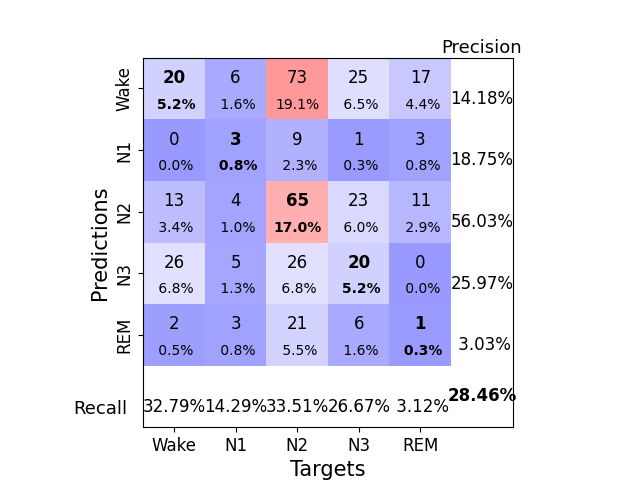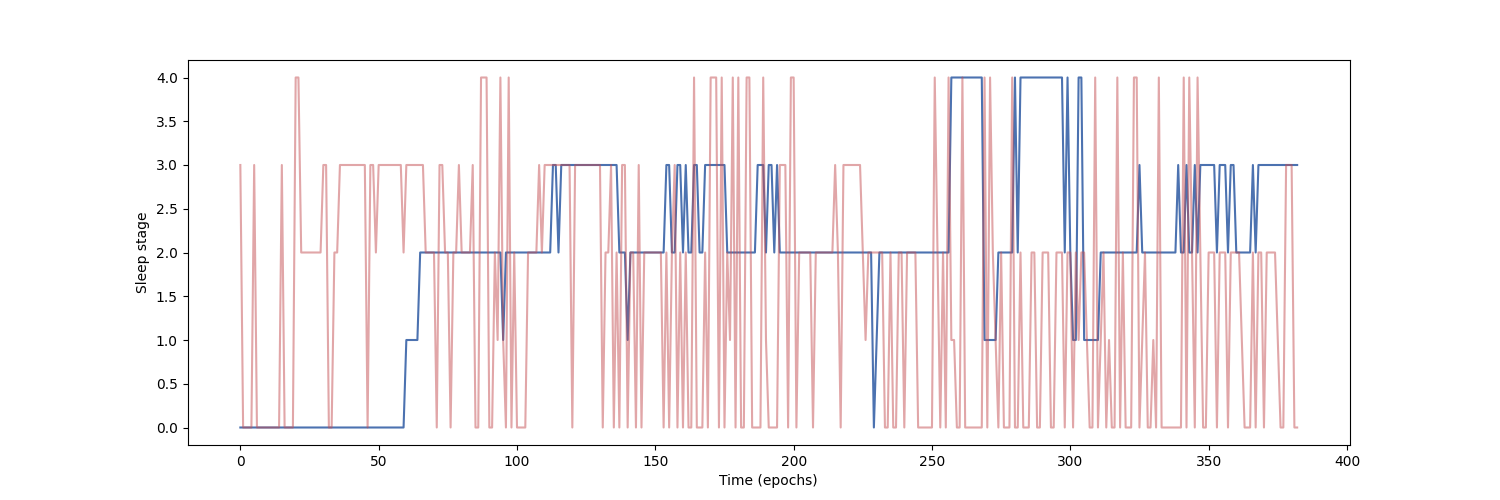Note
Go to the end to download the full example code
Sleep staging on the Sleep Physionet dataset using Chambon2018 network#
This tutorial shows how to train and test a sleep staging neural network with Braindecode. We adapt the time distributed approach of [1] to learn on sequences of EEG windows using the openly accessible Sleep Physionet dataset [2] [3].
# Authors: Hubert Banville <hubert.jbanville@gmail.com>
#
# License: BSD (3-clause)
Loading and preprocessing the dataset#
Loading#
First, we load the data using the
braindecode.datasets.sleep_physionet.SleepPhysionet class. We load
two recordings from two different individuals: we will use the first one to
train our network and the second one to evaluate performance (as in the MNE
sleep staging example).
from numbers import Integral
from braindecode.datasets import SleepPhysionet
subject_ids = [0, 1]
dataset = SleepPhysionet(
subject_ids=subject_ids, recording_ids=[2], crop_wake_mins=30)
Preprocessing#
Next, we preprocess the raw data. We convert the data to microvolts and apply a lowpass filter. We omit the downsampling step of [1] as the Sleep Physionet data is already sampled at a lower 100 Hz.
from braindecode.preprocessing import preprocess, Preprocessor
from numpy import multiply
high_cut_hz = 30
factor = 1e6
preprocessors = [
Preprocessor(lambda data: multiply(data, factor), apply_on_array=True), # Convert from V to uV
Preprocessor('filter', l_freq=None, h_freq=high_cut_hz)
]
# Transform the data
preprocess(dataset, preprocessors)
/home/runner/work/braindecode/braindecode/braindecode/preprocessing/preprocess.py:55: UserWarning: Preprocessing choices with lambda functions cannot be saved.
warn('Preprocessing choices with lambda functions cannot be saved.')
<braindecode.datasets.sleep_physionet.SleepPhysionet object at 0x7f4541467fd0>
Extract windows#
We extract 30-s windows to be used in the classification task.
from braindecode.preprocessing import create_windows_from_events
mapping = { # We merge stages 3 and 4 following AASM standards.
'Sleep stage W': 0,
'Sleep stage 1': 1,
'Sleep stage 2': 2,
'Sleep stage 3': 3,
'Sleep stage 4': 3,
'Sleep stage R': 4
}
window_size_s = 30
sfreq = 100
window_size_samples = window_size_s * sfreq
windows_dataset = create_windows_from_events(
dataset,
trial_start_offset_samples=0,
trial_stop_offset_samples=0,
window_size_samples=window_size_samples,
window_stride_samples=window_size_samples,
preload=True,
mapping=mapping
)
Window preprocessing#
We also preprocess the windows by applying channel-wise z-score normalization in each window.
from sklearn.preprocessing import scale as standard_scale
preprocess(windows_dataset, [Preprocessor(standard_scale, channel_wise=True)])
<braindecode.datasets.base.BaseConcatDataset object at 0x7f4542374550>
Split dataset into train and valid#
We split the dataset into training and validation set taking every other subject as train or valid.
split_ids = dict(train=subject_ids[::2], valid=subject_ids[1::2])
splits = windows_dataset.split(split_ids)
train_set, valid_set = splits["train"], splits["valid"]
Create sequence samplers#
Following the time distributed approach of [1], we need to provide our neural network with sequences of windows, such that the embeddings of multiple consecutive windows can be concatenated and provided to a final classifier. We can achieve this by defining Sampler objects that return sequences of window indices. To simplify the example, we train the whole model end-to-end on sequences, rather than using the two-step approach of [1] (i.e. training the feature extractor on single windows, then freezing its weights and training the classifier).
import numpy as np
from braindecode.samplers import SequenceSampler
n_windows = 3 # Sequences of 3 consecutive windows
n_windows_stride = 3 # Maximally overlapping sequences
train_sampler = SequenceSampler(
train_set.get_metadata(), n_windows, n_windows_stride, randomize=True
)
valid_sampler = SequenceSampler(valid_set.get_metadata(), n_windows, n_windows_stride)
# Print number of examples per class
print('Training examples: ', len(train_sampler))
print('Validation examples: ', len(valid_sampler))
Training examples: 372
Validation examples: 383
We also implement a transform to extract the label of the center window of a sequence to use it as target.
Finally, since some sleep stages appear a lot more often than others (e.g. most of the night is spent in the N2 stage), the classes are imbalanced. To avoid overfitting on the more frequent classes, we compute weights that we will provide to the loss function when training.
from sklearn.utils import compute_class_weight
y_train = [train_set[idx][1] for idx in train_sampler]
class_weights = compute_class_weight('balanced', classes=np.unique(y_train), y=y_train)
Create model#
We can now create the deep learning model. In this tutorial, we use the sleep staging architecture introduced in [1], which is a four-layer convolutional neural network. We use the time distributed version of the model, where the feature vectors of a sequence of windows are concatenated and passed to a linear layer for classification.
import torch
from torch import nn
from braindecode.util import set_random_seeds
from braindecode.models import SleepStagerChambon2018, TimeDistributed
cuda = torch.cuda.is_available() # check if GPU is available
device = 'cuda' if torch.cuda.is_available() else 'cpu'
if cuda:
torch.backends.cudnn.benchmark = True
# Set random seed to be able to roughly reproduce results
# Note that with cudnn benchmark set to True, GPU indeterminism
# may still make results substantially different between runs.
# To obtain more consistent results at the cost of increased computation time,
# you can set `cudnn_benchmark=False` in `set_random_seeds`
# or remove `torch.backends.cudnn.benchmark = True`
set_random_seeds(seed=31, cuda=cuda)
n_classes = 5
# Extract number of channels and time steps from dataset
n_channels, input_size_samples = train_set[0][0].shape
feat_extractor = SleepStagerChambon2018(
n_channels,
sfreq,
n_outputs=n_classes,
n_times=input_size_samples,
return_feats=True
)
model = nn.Sequential(
TimeDistributed(feat_extractor), # apply model on each 30-s window
nn.Sequential( # apply linear layer on concatenated feature vectors
nn.Flatten(start_dim=1),
nn.Dropout(0.5),
nn.Linear(feat_extractor.len_last_layer * n_windows, n_classes)
)
)
# Send model to GPU
if cuda:
model.cuda()
Training#
We can now train our network. braindecode.EEGClassifier is a
braindecode object that is responsible for managing the training of neural
networks. It inherits from skorch.NeuralNetClassifier, so the
training logic is the same as in
Skorch.
Note
We use different hyperparameters from [1], as these hyperparameters were optimized on a different dataset (MASS SS3) and with a different number of recordings. Generally speaking, it is recommended to perform hyperparameter optimization if reusing this code on a different dataset or with more recordings.
from skorch.helper import predefined_split
from skorch.callbacks import EpochScoring
from braindecode import EEGClassifier
lr = 1e-3
batch_size = 32
n_epochs = 10
train_bal_acc = EpochScoring(
scoring='balanced_accuracy', on_train=True, name='train_bal_acc',
lower_is_better=False)
valid_bal_acc = EpochScoring(
scoring='balanced_accuracy', on_train=False, name='valid_bal_acc',
lower_is_better=False)
callbacks = [
('train_bal_acc', train_bal_acc),
('valid_bal_acc', valid_bal_acc)
]
clf = EEGClassifier(
model,
criterion=torch.nn.CrossEntropyLoss,
criterion__weight=torch.Tensor(class_weights).to(device),
optimizer=torch.optim.Adam,
iterator_train__shuffle=False,
iterator_train__sampler=train_sampler,
iterator_valid__sampler=valid_sampler,
train_split=predefined_split(valid_set), # using valid_set for validation
optimizer__lr=lr,
batch_size=batch_size,
callbacks=callbacks,
device=device,
classes=np.unique(y_train),
)
# Model training for a specified number of epochs. `y` is None as it is already
# supplied in the dataset.
clf.fit(train_set, y=None, epochs=n_epochs)
epoch train_bal_acc train_loss valid_acc valid_bal_acc valid_loss dur
------- --------------- ------------ ----------- --------------- ------------ ------
1 0.2136 1.5768 0.0888 0.2000 1.6372 1.5977
2 0.2036 1.4788 0.0888 0.2000 1.6676 1.4921
3 0.2324 1.4033 0.0966 0.2102 1.6337 1.5023
4 0.2888 1.3407 0.1149 0.2465 1.6790 1.5318
5 0.3993 1.2126 0.4517 0.4013 1.6235 1.6800
6 0.5294 1.0967 0.2768 0.4076 1.6179 1.5747
7 0.5755 0.9662 0.5927 0.5671 1.3689 1.5097
8 0.6251 0.8904 0.7076 0.5786 1.2952 1.4943
9 0.6877 0.8148 0.7154 0.5876 1.3450 1.5740
10 0.6860 0.7449 0.5196 0.5269 1.6322 1.5012
<class 'braindecode.classifier.EEGClassifier'>[initialized](
module_=Sequential(
(0): TimeDistributed(
(module): SleepStagerChambon2018(
(spatial_conv): Conv2d(1, 2, kernel_size=(2, 1), stride=(1, 1))
(feature_extractor): Sequential(
(0): Conv2d(1, 8, kernel_size=(1, 50), stride=(1, 1), padding=(0, 25))
(1): Identity()
(2): ReLU()
(3): MaxPool2d(kernel_size=(1, 13), stride=(1, 13), padding=0, dilation=1, ceil_mode=False)
(4): Conv2d(8, 8, kernel_size=(1, 50), stride=(1, 1), padding=(0, 25))
(5): Identity()
(6): ReLU()
(7): MaxPool2d(kernel_size=(1, 13), stride=(1, 13), padding=0, dilation=1, ceil_mode=False)
)
)
)
(1): Sequential(
(0): Flatten(start_dim=1, end_dim=-1)
(1): Dropout(p=0.5, inplace=False)
(2): Linear(in_features=816, out_features=5, bias=True)
)
),
)
Plot results#
We use the history stored by Skorch during training to plot the performance of the model throughout training. Specifically, we plot the loss and the balanced balanced accuracy for the training and validation sets.
import matplotlib.pyplot as plt
import pandas as pd
# Extract loss and balanced accuracy values for plotting from history object
df = pd.DataFrame(clf.history.to_list())
df.index.name = "Epoch"
fig, (ax1, ax2) = plt.subplots(2, 1, figsize=(8, 7), sharex=True)
df[['train_loss', 'valid_loss']].plot(color=['r', 'b'], ax=ax1)
df[['train_bal_acc', 'valid_bal_acc']].plot(color=['r', 'b'], ax=ax2)
ax1.set_ylabel('Loss')
ax2.set_ylabel('Balanced accuracy')
ax1.legend(['Train', 'Valid'])
ax2.legend(['Train', 'Valid'])
fig.tight_layout()
plt.show()

Finally, we also display the confusion matrix and classification report:
from sklearn.metrics import confusion_matrix, classification_report
from braindecode.visualization import plot_confusion_matrix
y_true = [valid_set[[i]][1][0] for i in range(len(valid_sampler))]
y_pred = clf.predict(valid_set)
confusion_mat = confusion_matrix(y_true, y_pred)
plot_confusion_matrix(confusion_mat=confusion_mat,
class_names=['Wake', 'N1', 'N2', 'N3', 'REM'])
print(classification_report(y_true, y_pred))

precision recall f1-score support
0 0.14 0.33 0.20 61
1 0.19 0.14 0.16 21
2 0.56 0.34 0.42 194
3 0.26 0.27 0.26 75
4 0.03 0.03 0.03 32
accuracy 0.28 383
macro avg 0.24 0.22 0.21 383
weighted avg 0.37 0.28 0.31 383
Finally, we can also visualize the hypnogram of the recording we used for validation, with the predicted sleep stages overlaid on top of the true sleep stages. We can see that the model cannot correctly identify the different sleep stages with this amount of training.
import matplotlib.pyplot as plt
fig, ax = plt.subplots(figsize=(15, 5))
ax.plot(y_true, color='b', label='Expert annotations')
ax.plot(y_pred.flatten(), color='r', label='Predict annotations', alpha=0.5)
ax.set_xlabel('Time (epochs)')
ax.set_ylabel('Sleep stage')

Text(150.22222222222223, 0.5, 'Sleep stage')
Our model was able to learn despite the low amount of data that was available (only two recordings in this example) and reached a balanced accuracy of about 36% in a 5-class classification task (chance-level = 20%) on held-out data.
Note
To further improve performance, more recordings should be included in the training set, and hyperparameters should be selected accordingly. Increasing the sequence length was also shown in [1] to help improve performance, especially when few EEG channels are available.
References#
Total running time of the script: (1 minutes 59.132 seconds)
Estimated memory usage: 10 MB